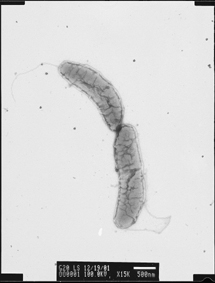Desulfovibrio desulfuricans strain G20 is a spontaneously nalidixic acid resistant derivative of the wild-type strain G100A that was isolated from an oil well corrosion site (Weimer et al., 1988). Strain G20 has also been cured of a 2.3-kb cryptic plasmid found in the freshly isolated strain (Wall et al., 1993). The %GC of the genes sequenced to date is about 60%. From examination of the chromosomal structure by CHEF gel analysis, the single chromosomal element appears to be about 3.2 Mb (Wickman, 1997). There is no reliable information regarding repeat elements. Motivation for
Sequencing The economic and environmental processes which have historically driven the desire to understand the metabolism of the SRB include underground corrosion of iron or steel gas or water pipes and generation of noxious sulfide during digestion of domestic and agricultural wastes. These bacteria have been a particular problem for the petroleum industry not only because of their role in metal corrosion but also because of the souring of the petroleum by the hydrogen sulfide generated and the health hazard presented by this gas. D. desulfuricans G20 originated from a corrosion site and rapidly corrodes mild steel (Odom, 1993). All these interfaces with human activities result from the energy generating processes of these anaerobes. While many proteins that are candidates for bioenergetic pathways have been studied (Peck and LeGall, 1994), the connections and complete pathways remain to be resolved. In particular, the possibility that these bacteria utilize a novel hydrogen cycling mechanism to generate or augment the proton gradient across the cytoplasmic membrane (Odom and Peck, 1981) has stimulated much discussion. More recent studies (Lovley et al., 1993) have documented the ability of a number of Desulfovibrio strains to reduce toxic metals such as uranium and chromium, a process that results in the production of less water-soluble species. The modification of solubility properties brought about by changing the redox state of the metal presents itself as a potential avenue for bioremediation of contaminated ground waters or soils. The genetically accessible strains of Desulfovibrio, including G20 (Payne et al., 2002), mediate this reduction. Thus studies for the elucidation of the electron pathway, the metal reductase(s), their regulation and their specificity deserve special attention. Microarray analyses will prove most valuable in sorting out the effects of toxic metals and the bioenergetics of these microbes. References: Lovley, D.R., E.E. Roden, E.J.P. Phillips, and J.C. Woodward. 1993a. Enzymatic iron and uranium reduction by sulfate-reducing bacteria. Marine Geol. 113:41-53. Odom, J.M. 1993. Industrial and environmental activities of sulfate-reducing bacteria. In J.M. Odom and Rivers Singleton, Jr. (eds) The sulfate-reducing bacteria: contemporary perspectives, Springer Verlag, New York and Berlin, pp. 189-210. Odom, J.M., and Peck, Jr., H.D. 1981. Hydrogen cycling as a general mechanism for energy coupling in the sulfate reducing bacteria, Desulfovibrio sp. FEMS Microbiol. Lett. 12:47-50. Payne, R. B., L. Casalot, J. A. Ringbauer, Jr., B. Rapp-Giles, and J.D. Wall. Uranium reduction by Desulfovibrio desulfuricans strain G200 and a cytochrome c3 mutant. Appl. Environ. Microbiol. (In press). Peck, Jr., H. D., and J. LeGall (eds). 1994. Inorganic microbial sulfur metabolism. Meth. Enzymol. Vol. 243. Wall, J.D., B.J. Rapp-Giles, and M. Rousset. 1993. Characterization of a small plasmid from Desulfovibrio desulfuricans and its use for shuttle vector construction. J. Bacteriol. 175:4121-4128. Weimer, P.J., M. J. van Kavelaar, C. B. Michel, and T. K. Ng. 1988. Effect of phophate on the corrosion of carbon steel and on the composition of the corrosion products in two-stage chemostat cultures of Desulfovibrio desulfuricans G100A. Appl. Environ. Microbiol. 54:386-396. Wickman, T. 1997. A physical and genetic map of the chromosome of the sulfate-reducing bacterium Desulfovibrio desulfuricans G20. Ph.D. Dissertation, University of Missouri. |
||
|
||
Desulfovibrio desulfuricans G20

